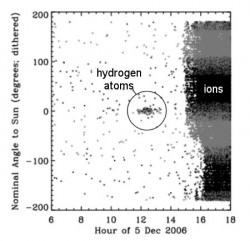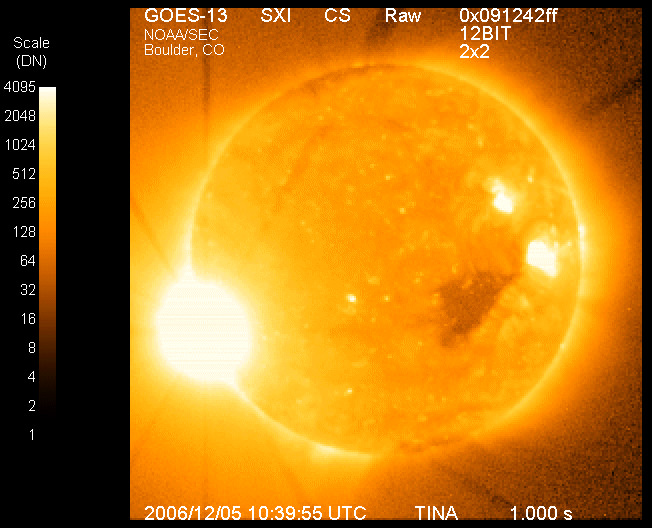[/caption]
In 2006, one of the largest solar flares observed for 30 years erupted, saturating X-ray cameras on board observatories orbiting Earth. The December 5th event was a powerful X-ray flare, registering “X9” on the scale of powerful “X-class” flares. Even though flares weighing in at X20+ have been observed, the X9 is a rare event all the same. However, this 2006 flare is fast becoming known not only for its energetic characteristics. Shortly after the flare, solar astronomers expected to see a flood of interplanetary ions being ejected by the Sun. However, they detected something else; not only a particle they weren’t expecting, but a particle that shouldn’t be there…
When a blast the size of a hundred million nuclear bombs detonates, you wouldn’t expect anything to be intact at ground-zero, would you? In the case of solar flares, a huge amount of magnetic energy is unleashed through a process known as reconnection, quickly accelerating and heating solar plasma. Depending on the conditions, different solar flare energies are possible, but in the case of the Dec. 5th 2006 flare, solar plasma was rapidly and violently accelerated, unleashing X-ray radiation. At the flare site, within the knotted and twisted magnetic flux, plasma temperatures can soar to 10-20 million Kelvin (occasionally, for the biggest flares, 100 million Kelvin). In these conditions, nothing stays intact. Any atoms in the local area become stripped of their electrons, leaving an energetic soup of ionized particles (like protons and helium nuclei) and electrons.
So you can imagine the surprise of a group of solar physicists using data from the twin Solar Terrestrial Relations Observatory (STEREO) spacecraft orbiting the Sun (one ahead of the Earth’s orbit, and one behind), when they detected a jet of pure neutral hydrogen atoms emanating from the flare.
“We’ve detected a stream of perfectly intact hydrogen atoms shooting out of an X-class solar flare,” says Richard Mewaldt of Caltech,. “What a surprise! These atoms could be telling us something new about what happens inside flares.”
“No other elements were present, not even helium (the sun’s second most abundant atomic species). Pure hydrogen streamed past the spacecraft for a full 90 minutes.”

At first glance, the impossible had been achieved; a solar flare had somehow manufactured, then sorted the neutral hydrogen from the soup of plasma and shot it into space. But this produced a very perplexing puzzle: neutral hydrogen, lots of it, has been detected as a result of a solar flare, and yet these atoms cannot exist in the extreme environment surrounding the flare site. What gives?
Actually, these hydrogen atoms were not generated inside the flare, they formed after the flare as the products from the explosion spiralled into interplanetary space.
“We believe they began their journey to Earth in pieces, as protons and electrons,” said Mewaldt. “Before they escaped the sun’s atmosphere, however, some of the protons recaptured an electron, forming intact hydrogen atoms. The atoms left the sun in a fast, straight shot before they could be broken apart again.”
The reason why these neutral atoms appeared at STEREO faster than the ion cloud is because the neutral hydrogen did not get influenced (slowed down) by the Sun’s magnetic field; the atoms shot out, in a straight line, rather than being deflected by magnetic flux. And how did they form? Physicists believe the protons “recaptured” the free electrons in the space between the flare and detector through the well known mechanisms radiative recombination and charge exchange.
Now, solar physicists want to replicate these findings to see whether these hydrogen jets are a common feature of solar flares… but they might have to wait a while, the Sun is still enjoying its quiet spell...
Source: NASA


Well, thanks to trolls, we not only get to learn about cutting-edge astronomical and cosmological science, but also about psychopathology. A towfer! 😉
Whoops — I said “towfer,” but meant “twofwer.” Sorry for the typo.
😀
Sooooo… . . anyone wanna talk physics? I have a pile of solar physics counter arguments under my desk, ready to be unleashed. However, I had no counter argument for the strange comment left by the guy at the back of the class…
Ho hum
Can’t we just forget about The Plasma Universe and talk about gravity more? LOL @ gravity. Plasma: the other 99.99% of the universe.
Stop trolling Oil. From looking at your blog, I see you actually believe the nonsense you spout in the comments on this board — I’ve heard of global warming deniers, but never before have I heard of someone who denies the existence of gravity (and about 90% of the rest of reality).
It would be nice if the site admins would take action on messages like yours — they simply disrupt the topics you post them in. (Psst admins, you can delete this one along with his).
“Can’t we just forget about The Plasma Universe and talk about gravity more? LOL @ gravity. Plasma: the other 99.99% of the universe.”
A sentence formed neither to educate nor to discuss, and certainly made to provoke – hence, a Troll.
Not only is he a troll, but he’s a troll thats formerly been banned from the BAUT forum (according to his blog).
Actually he is Terence Witt on another prepublication test.
Pure hydrogen, Nice.
Spaceship with a Big scoop. Seems that where there is a sun you have all the fuel you need.
But do you?
I wonder if the concentrations of hydrogen released could be harvested?
Hypothetically, given a Plasma Engine like VASIMR, potentially powered by a nuclear reactor like the one being looked at in the Prometheus project. That uses Hydrogen or helium as fuel.
I’m wondering if you could use such outbursts as a source of fuel.?
If there is such a (relatively) simple explanation for this, why is it that we haven’t observed this sort of thing before? It seems like some amount of radiative recombination/charge exchange should occur with most solar flares…
I know that STEREO has only been up there since 2006, but haven’t there been other instruments available to do this kind of work before now?
And then one last thing, but if there are enough electrons hanging to be captured by passing protons to form noticeable amounts of hydrogen, and if helium nuclei are present in the plasma, wouldn’t we see at least some neutral helium?
I know that it would be significantly less, as it would have to capture two electrons rather than one. Maybe the intense plasma conditions favor full ionization (if that’s the right word) and reduce everything down into protons rather than nuclei, or maybe the radiative recombination/charge exchange process is more complex than just a positive thing grabbing a negative thing as it shoots by, and this added complexity prevents neutral He from forming. I have no idea.
Either way, thanks in advance for the answers, and hooray science.
@Bill, Thats exactly my first thought too… Y is it that they didnt detect these particles before… But i just read through STEREO webpage and found that they have this specialised instrument to just study the ion particles in the solar wind… But i dont know whether any other instrument has this particle analyser as well…
Still it is a very interesting result indeed!!
Given that this burst of hydrogen within or resulting from a flare is somethig that we did not know about, and given that that it is unlikely that this is the first time in the Sun’s history that this has happened, what does this do to age estimates and claims of pristine surfaces for solar System objects? While having a more complete picture of natural processes is great, I can’t help but think that at least one Solar System scientist is doing a bit of cussing today.
Is a simpler explanation that the pure hydrogen atoms were stripped off hydrogen gas normally held by gravity, and were then enabled to escape during this flare.
Bill, about not detecting neutral helium.
This is a wild shot in the dark, but…
1. During the flare, both hydrogen and helium are stripped of the electrons
2. The chance for a proton to recapture 1 electron is much larger than the chance that the helium nuclei will recapture 2 electrons, and as long as the atoms are inonized they are slowed by the magnetic feld.
3. As soon as the atom is neutralised, it moves freely of the magnetic field, separating out the hydrogen faster than the helium.
This can only be true if the subsequent flood of charged particles include both hydrogen and helium, wich the article doesnt mention.
Right, so it should be statistically less likely, but there still should be some measurable amount of neutral He, especially because the helium nucleus would pull on electrons with twice the force of a proton. And then, once it had captured the first electron, it would then pull on the second electron with the same force as a proton (hydrogen nucleus) would.
This is what I’m picturing:
He nuclei & protons pass through the cloud of electrons at a very high speed. Initially, the He nuclei exert a greater force on the electrons, so you get a 2:1 ratio of He(1-) to H(0). However, the instant that any He(1-) is created, it begins acting like a proton, so you would think that the first few He(1-) to form (molecules on the leading edge of the ion cloud) would still have a good number of electrons to pick from to make it to He(0), as they passed through the cloud of electrons.
Actually, come to think of it there might still be an answer. I’m picturing the two clouds of opposing ions as sort of oblong shapes, flowing into and through each other head on, as they should be traveling in anti-parallel directions (as the E field pushes one in a given direction and pulls the other in the opposite direction). However, if the electron could was wide but only a few atoms thick, the He (1-) wouldn’t have a chance to become neutral, because grabbing just one electron would mean that it was already through the cloud…
ok, so now THIS is what I’m picturing:
a sort of plane of electrons only a few electrons thick, tangent to the surface of the sun (though high above it). The oblong cloud of electrons flow through it along the normal vector (though I guess it wouldn’t have to be perfectly orthogonal… the deviation from 90 degrees would depend on exactly how thick the cloud was). So, He(2+) ions fly through, but can only grab one electron because of the thinness of the field. Protons, on the other hand, become neutral hydrogen molecules and continue on their resent course. Also, hopefully the electrons wouldn’t become exhausted as the positive ion cloud passed through, as repulsion between electrons would fill the gap.
I don’t know much about solar physics, so I don’t know if this is likely or even possible, but maybe it’s an explanation?
And sorry for taking so much space up… I apparently lack focus 😉
Bill, It takes twice as much energy to accelerate Helium as it does Hydrogen. The Hydrogen will still arrive first at the detector and the theoretical plane (?shell) of electrons.
heh, wow, I definitely over-thought that one…
Mate- don’t assume I know what the hell I’m talking about either 🙂